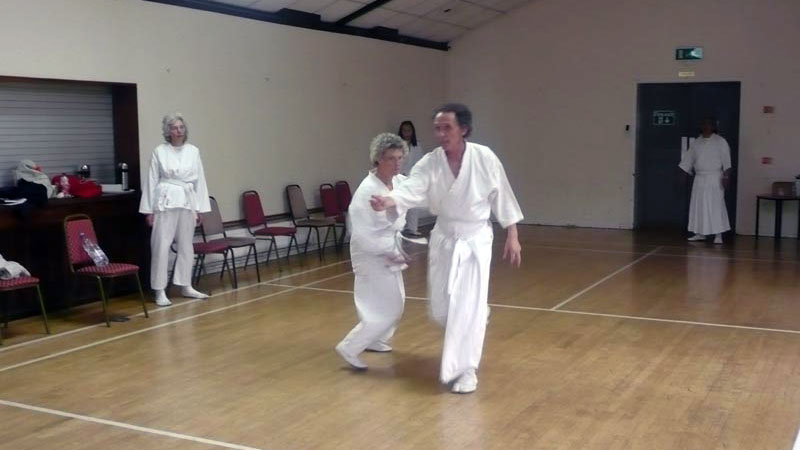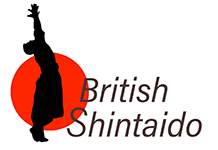
2015 has been a memorable year in my career as a Shintaido instructor. I have had the strange impression that things are trying to happen by themselves, but somehow not quite taking off.
For over two years I have been running a Wednesday-evening class at the local Quaker Centre in Reading. With just three regular students the class never comes close to breaking even, so I find myself constantly subsidising the hall fee to keep it going. Luckily my silhouette business is going well, so I can easily afford to do this; I have long ago resigned myself to this being the way things are!
Yet there are compensations. My class, just in the last few months, has begun to move into deep waters. It is travelling that well-trodden path from beginner to intermediate level. I can feel it in my students and the way the sessions run. It would no longer be such an easy task to integrate a complete beginner into the class without altering its nature; for any instructor this progression is a reward in itself.
There are also spin-offs. I spent most of the year trying, together with one of my students, to establish a University of Reading bojutsu club. We practiced outside and created an official UoR Club, allowing us to advertise our presence to the student body. During the whole year no more than half a dozen students ever came to try it out, and none came back for a second session. Yet throughout the year my one bojutsu student progressed from kata to kata and has developed a good working knowledge of basic Shintaido bojutsu.
Even these non-returning students have not been a waste of time. One of them, the president of the UoR Japanese Society, promptly invited me to give a lecture on the origins and practice of Shintaido. Sadly, it was not well attended – possibly because of the unknown and un-sexy name ‘Shintaido’ – yet was well received by those who did attend. I wanted to finish my talk by giving them a practical experience of Shintaido, so offered them a choice between tenshingoso, eiko and wakame taiso (having explained the origins and nature of each in my talk). They chose wakame taiso. It turned out to be a wise choice and the talk ended on a calm and meditative note, the students visibly changed by their short and intense experience of Shintaido. The lecture was a happy experience and one which I would love the opportunity to repeat.
Then there was Brookfields School. At the start of 2015 I was approached by this local SEN Secondary School to teach Shintaido to some of their older students. Many of these students were autistic while others had a variety of special needs to consider. After a few ‘taster’ sessions in the spring I was booked to teach a regular Monday morning class throughout the summer term. The classes were large, noisy and chaotic, yet seemed enjoyable and successful. The students made remarkable progress in the few months I was there, I was really amazed! Their favourite movement was eiko, the students almost literally jumping for joy when I announced it, soon after the warm up at every class.
Sadly my students were all in their final year. During the last two classes of summer some students from the year below did join us, with a view to gauging their suitability for Shintaido, however I think they felt rather overwhelmed by the already-quite-advanced classes they experienced. For whatever reason I cannot be sure, but the class was not renewed in September.
For me, the summer of 2015 was memorable in being the only time in my Shintaido career when I have found myself teaching three regular weekly classes at once: Brookfields SEN Shintaido, Quaker Hall Shintaido and the UoR Bojutsu Club. I realised my diary was full, if the opportunity to teach another class had come along I would have had to turn it down, I had found my natural limit!
Finally, there’s my Moldovan student, who contacted me out of the blue last summer looking for a bojutsu instructor in London. Not knowing who to recommend I offered him my services for private lessons (at a suitable fee) which, to my surprise, he accepted. So far we have met half a dozen times, he has bought a bo and is progressing slowly through the bojutsu curriculum. We meet in Regents Park when he is in London (an irregular occurrence) whenever both our busy schedules and the weather permit. Regents Park is a wonderful place to practice full of joggers and a variety of fitness classes. On one occasion we shared the space with a giant marathon run – snaking continuously through the park throughout our 90 minutes – and on another with a frisbee convention. The space is so full of physical activity that nobody notices the pair of bojutsu practitioners locking their staff together.
Teaching Shintaido is always a struggle alongside my busy and irregular silhouette-cutting schedule. There are frequent timetable clashes when I need the services of stand-in instructors (thank you Peter and Jamie). Although I do find time to teach there is never enough to publicise the class, so Reading remains sadly devoid of Shintaido posters. I desperately need help in managing the growth of Reading Shintaido and attracting new students. Yet still I have this strange impression that things are somehow trying to happen by themselves…
